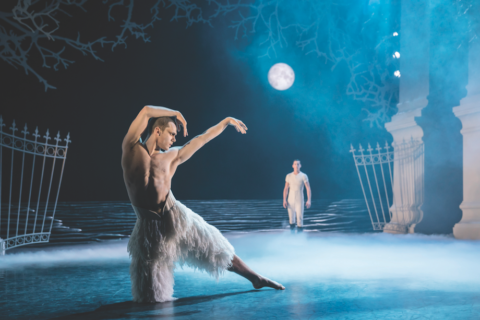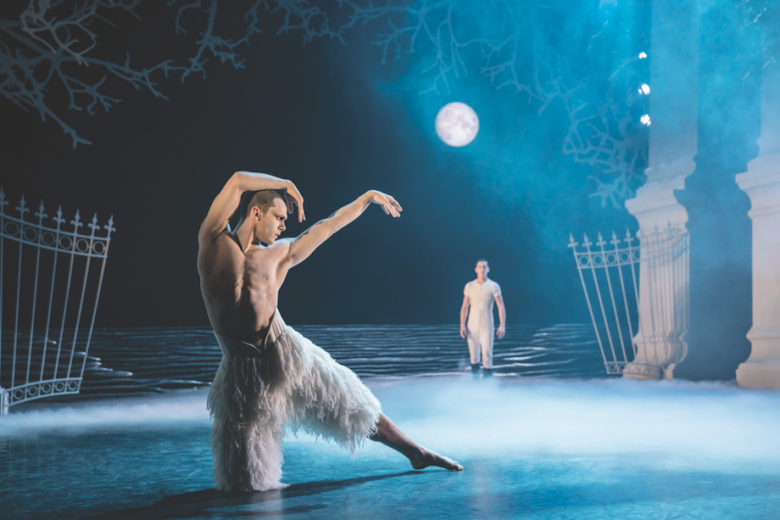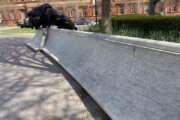
Since 1876, Tchaikovsky’s iconic ballet “Swan Lake” has spread its wings to take on many forms, the most unique of which was the 1995 production by Matthew Bourne.

His daring male-swan reimagining wowed Broadway, winning three Tony Awards, including Best Director of a Musical, Best Choreography and Best Costume Design.
This week, you can catch his gender-bending “Swan Lake” in its Kennedy Center debut, the latest stop for Bourne’s aptly-named dance company New Adventures.
“It’s a story that really moves people and has done so for decades now,” Bourne told WTOP. “People are often in tears at the end of this piece, as they should be in ‘Swan Lake’ [with] this incredibly powerful, tragic music at the end. I think we rise to the occasion with these male swans and people seem to agree. You see all the hankies come out at the end of the show. That’s very gratifying.”
How did he get the idea to replace the female lead as a male swan?
“We’re not a classical ballet company; we’re a Dance Theatre Company, so if we were going to do ‘Swan Lake’ on tour, we needed to do it in our own different way,” Bourne said. “Casting men instead of women as the swans was attention grabbing, but it was also fascinating for the story of a prince who can’t love who he wants to love, which is again very contemporary. … It threw open so many interesting psychological things.”
Not to be exclusionary, women still make up about a third of the total cast.
“The whole cast of ‘Swan Lake’ grew up with this piece,” Bourne said. “I’m like some sort of historic figure to them — many of them were not born when I made the piece. … You get incredible passion from the cast for this show because it’s their dream roles.”
The lead role is split by three acclaimed dancers from varied backgrounds.
“We have a dancer that’s come up through my company, Will Bozier, who is terrific and has incredible power, magnetism and charisma on stage,” Bourne said. “We also have a dancer, Max Westwell, who came through the English National Ballet. … He’s powerful, sexy, all the things you want from the role. And for one show only in the Kennedy Center we have Matthew Ball … one of the Royal Ballet’s big new stars.”
They’ll be wearing the now-iconic costumes by designer Lez Brotherston.
“What he’s created in the show is pretty iconic,” Bourne said. “That look of the male swan is almost as famous as the ballerina in a tutu. It’s an incredible thing that we came up with together, this creature that looks like a combination of a man, a bird and an animal. Then we have face paint, this black line that goes down the forehead, across the nose and denotes a beak, but not in a literal way. It’s its own thing.”
Brotherston is one of Bourne’s longest collaborators, also designing the sets.
“It’s got an epic feel about it,” Bourne said. “The basic set is these very imposing columns that give a sense of a royal background, but then into those columns comes the nature, the park in the moonlight. It’s a bit difficult to explain because it’s kind of poetic and nightmarish sometimes. It’s like going inside somebody’s train of thought.”
The sets are bathed by lighting designer Paule Constable, who’s new to the team.
“She’s brought such incredible atmosphere to this piece now and the drama is brought out more strongly,” Bourne said. “She paints from darkness to light, which is unusual. … It creates incredible atmosphere and intimacy on a big stage. … If you think about a piece that was made 25 years ago … we [now] encompass a bit of projection in our storytelling, all sorts of theatrical things you can do now that you couldn’t do then.”
Of course, you still get the same hauntingly hypnotic score by Tchaikovsky.
“The music is the script to me,” Bourne said. “Tchaikovsky was the most amazing music to dance to, but also to tell stories to. … It’s contradictory actually. On one level, you’ve got the most melodious, beautiful music. … On the other side, you’ve got a very troubled man who’s conflicted in his life and his sexuality and was not always successful artistically in his day. That comes across in the music: incredible power, conflict and emotion. Put all those things together and you’ve got a winner.”
Bourne has staged all three Tchaikovsky ballets throughout his career, from “The Nutcracker” to “Sleeping Beauty” to “Swan Lake.”
“I loved doing them, each one of them, and reinterpreting what I hear in that music,” Bourne said. “One of the problems for a dance fan like myself is to try and wipe away those images I have in my head of the piece. So I have to listen and listen to the music to hear what else might be in it, because I don’t want to impose things onto the music. … It’s a really enjoyable challenge. … It’s hard to believe it’s been over 20 years.”
No matter how much time passes, he’ll never forget his triple win on Tony night.
“Tony night was crazy,” Bourne said. “For starters, the show had closed. ‘Swan Lake’ had been on for three or four months, which for a dance piece is pretty damn good, but we weren’t expecting to win anything because the Tonys are sometimes more likely to go to shows that are currently playing to support the shows. So we thought, ‘It’s nice to be here, but we’re not going to win anything.'”
When he heard his name called for Best Choreography, he was ecstatic.
“[That] was the one I was secretly hoping I might get,” Bourne said. “It was presented by my friend Alan Cumming, who’s always been a very good friend of mine. We started our careers together at the [Royal Shakespeare Company] and he was the presenter, so it was a lovely thing to have Alan present this award to me. It was just very special.”
After his win, Bourne settled back into his chair, unprepared to win Best Director.
“I thought I would relax … then I got another one, the director one, which I really wasn’t expecting at all,” Bourne said. “When I’m making my speech, I come face to face with Hal Prince, who was also nominated and he wasn’t looking very happy. He was directly in my eyeline. Cut to 20 years later, I finally met Hal Prince, somebody introduced us, and he just looked at me said, ‘You’re the guy who stole my Tony Award.'”
Later that night, his production won a third Tony for Best Costume Design.
“It was a complete thrill and one of the great memorable nights of my life,” Bourne said. “It was so lovely that my parents were there to see it. I managed to get them over for the Tony Awards, and they were both there, so that was a lovely thing.”
Decades later, how does he maintain an excitement to do the piece?
“I still feel great about it,” Bourne said. “I would probably feel not so great about it if I’d never had another successful piece. It would be like, OK, one hit wonder, [but] the fact that the company’s got 12 full-length pieces now that we revive is great. … ‘Swan Lake’ we’ll put to bed for probably four or five years once it finishes the American tour. It’s not around all the time, so when it comes back, it’ll be fresh again for me.”
It’s especially rewarding to bring it to the Kennedy Center for the first time ever.
“It’s such an iconic venue,” Bourne said. “It feels so prestigious. … When you arrive, it’s the most impressive, daunting building. … We have this relationship with audiences there who’ve gotten to know and like our work over a few years. We just hope we can keep bringing new pieces to the audience. They’re very appreciative of our work.”
Kennedy Center audiences will remember Bourne from last year’s “Cinderella.” Since then, he staged a revival of “The Red Shoes” in London before taking “Swan Lake” around Asia, Europe and now the U.S. tour. Through it all, what keeps him going?
“The thing that gets me up in the morning is the young talent,” Bourne said. “I don’t get tied to old casts like some choreographers and directors; they don’t really want to see anyone but the original people doing a role. … I’m constantly excited and renewed by the talent I get to work with and I want them to be good. It’s more about them than me. I want them to be good in these roles and I love nurturing that talent.”
Find more on the Kennedy Center website. Hear our full conversation below:








